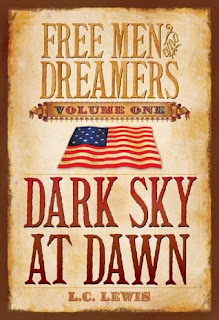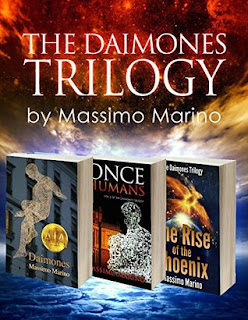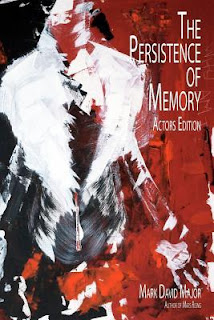Thanks for inviting me to share some of my culinary insights
from research on my Free Men and Dreamers
books. I popped into a gift shop in Williamsburg, Virginia in the early
days of work on book one, Dark Sky at
Dawn, and picked up a copy of a small, but priceless cookbook titled simply,
The Williamsburg Cookbook. It was
filled with primarily British recipes, most of which involved the ingredients
of their day—cream, butter, meat and potatoes. Journal entries from actual colonial
and pre-Civil War women helped me carve out the menus and beverages in DSAD and the other books in the series. These
journals made it apparent that the planning, growing, harvesting, and preparing
of food was a grueling, never-ending labor. I had a scene where the characters prepared
chickens for cooking. Imagine chasing, catching, killing, draining, gutting,
plucking, and burning off the pin-feathers of a bird, before you can even begin
your recipe. Perfectly seasoned fried chicken is my weakness, and I’ll never
take a fried chicken platter for granted again!
One dynamic that came up a lot in the series was “traveling”
food. From the import shortages the British and French embargoes were creating
for America in Dark Sky at Dawn, to
the shortages caused by war and destruction in later volumes, the struggle to
secure and prepare food, and the need for food that could travel, was a
constant concern.
The lead characters in the series—Jed and Hannah Pearson and
their neighbors—were frequently on foot, on horseback, or in a wagon, in rain
or snow or wind. The scenery provided the only picnic ambiance, because by the
time they stopped to eat, if they stopped at all, they were sore-bottomed, wind-burned,
sun-baked, or rain-soaked. Dinner on the fly was simple—biscuits, jerky, salted
or smoked slabs of meat, fruit in season, perhaps a boiled egg or two, and
coffee made from water that might have to be strained to remove insects, dirt,
and debris. Yum!!! Oftentimes, when they weren’t traveling in haste because of
enemies or weather, or when travelling a long distance, they might have to
forage, hunt, or fish for food along the way. Imagine waking up every morning
not knowing when or if there would be food on the table before nightfall. Too
many people today still face that challenge for different reasons.
I must admit, I do love the romance of the past. Life was
home-centered and unplugged, conversation and mealtimes were the social events
of the day, neighbors were lifetime friends nearly as essential as family, and
you knew the joy and satisfaction of seeing the fruit of your labors. As
beautiful as those things are, I’m grateful for the advantages of our day. I
love modern medicine, and I’m a huge fan plumbing—hot baths, flush toilets, the
ability to wash and sanitize food and prep areas, and the ease of having water
at your disposal without toting it up a hill, the gym memberships of the day.
I keep a cute picnic basket packed with matching plastic
ware, cups, plates, and gingham napkins, all at the ready, near a folded
blanket, for those spur-of-the-moment picnic adventures, however, I confess
that most of my picnics involve a quick stop at the “grab -and-go” section of
my local grocery for abundant and luscious cheese I didn’t make, sandwiches or
chicken grown and prepared elsewhere, and succulent prewashed fruit from a tree
I didn’t plant.
Instead of armed enemies and wild beasts, time presents the
greatest challenge in our day. I think we miss the sense of community and
family meal preparation provided back in the day. Neighbors would gather to
“bring in the sheaves” of wheat and to grind their grain into life-sustaining
flour. I can imagine the laughter and conversations that happened in the hours
when women filled kitchens to render lard, make jams, and prepare feats. In our
busy world, gathering moments happen less and less now.
I actually store wheat and have an electric grinder to churn
out freshly ground whole wheat flour. The children loved kneading their own
loaves of homemade bread on our weekly break-making day. The smell of baking
dough drew them back to the kitchen like an aromatic Pied Piper. Sadly, once
they headed to school and discovered “white, fluffy bread that comes in a
plastic bag” they didn’t want to take Mom’s homemade brown bread anymore, which
they said made them look like “poor kids.” They now pay five dollars or more a
loaf for bakery bread like that which they rejected back in the day.
Sadly, Mama sold out a bit, too. Travel food generally
involves a stop at a drive-through or from a carefully selected sack of items from
a grocer. And the location of on the fly meals generally depends on how much
slop we’re willing to subject our vehicle to.
The primary labor of our ancestors’ day was protecting
hearth and home, and growing and preserving food. Our challenges are the
same. Now we work to buy the home, and more
of our ingredients are provided by someone else. What doesn’t change is the joy
in gathering and working side-by-side to jointly meet our family’s needs. Families
need not be so removed from those experiences. I remember the satisfying hours
spent together with my children as we worked in and harvested from our garden.
Each pepper or green bean was a treasure they’d bring to me in wonder. Take any
family with a garden or even a tomato plant, and ask them how many life lessons
they drew from the divine magic of watching a mature plant grow from the seeming
nothingness of a single seed. There’s family strength and power in such
moments.
Food is more than sustenance. So much more. Our ancestors
knew it. I’m grateful we still revere and rediscover the art of the meal.
Thanks for stopping by to share your food for thought, Laurie!
You can find Laurie here:





